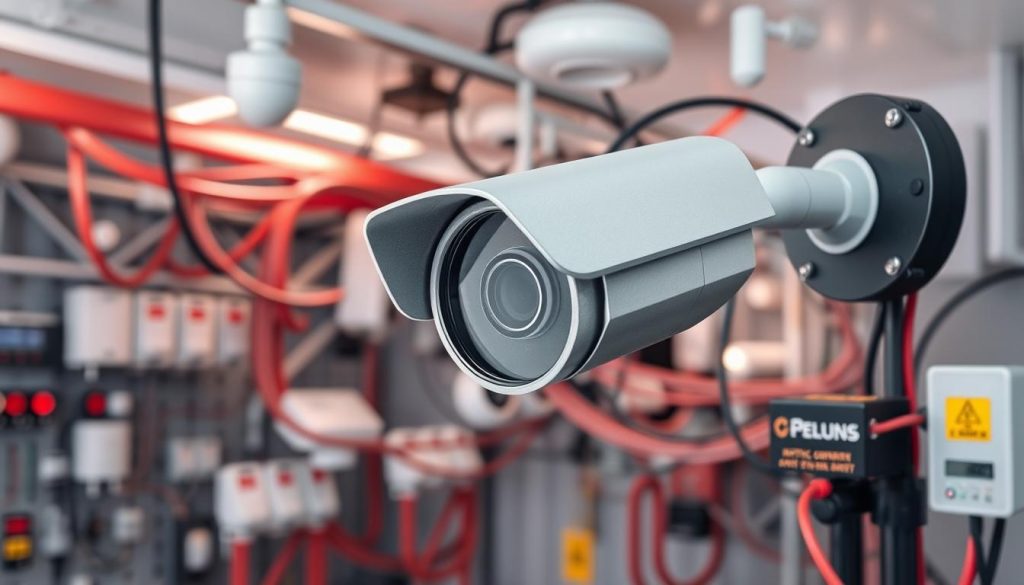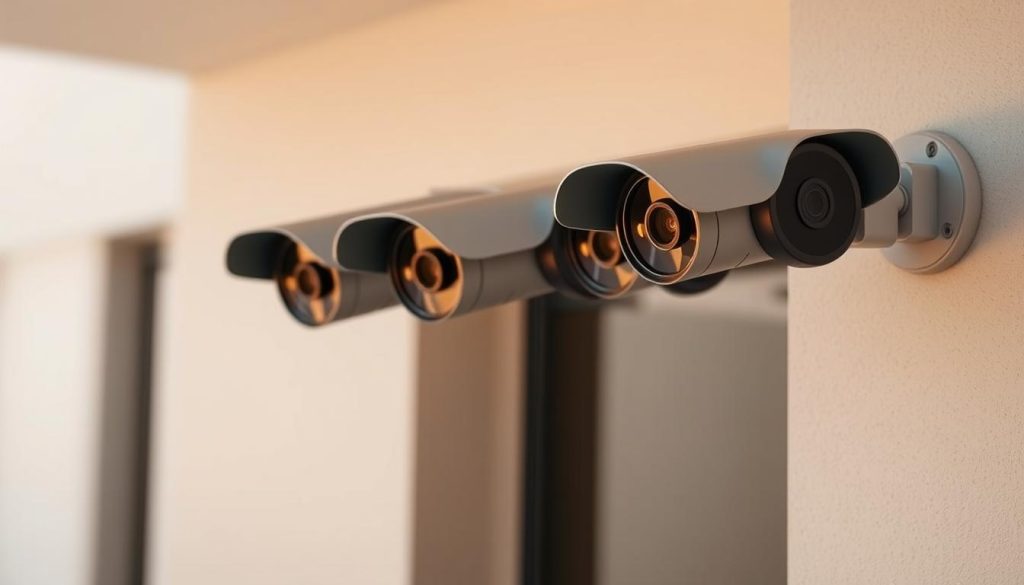Modern surveillance systems face growing threats from wireless interference. Recent FBI data shows a 38% spike in tech-assisted burglaries, with criminals using portable jammers to disable smart home devices. These attacks often exploit vulnerabilities in standard WiFi frequencies.
Advanced solutions like the Reolink Altas PT Ultra combine 5GHz transmission with local storage to counter interference. Minneapolis authorities recently dismantled a burglary ring relying on $50 jamming tools—highlighting the need for upgraded protection.
Key Takeaways
- Wireless jamming incidents increased significantly in 2023
- Dual-frequency cameras reduce vulnerability to interference
- Local storage ensures footage survives signal disruptions
- Encryption adds an extra layer of defense
- Regular firmware updates patch security gaps
Understanding WiFi Jamming and Its Threat to Security Cameras
Criminals increasingly exploit radio frequencies to disable smart monitoring devices. This tactic, called WiFi jamming, floods wireless networks with overpowering signals, disrupting surveillance feeds. Basic jammers costing under $50 can block both 2.4GHz and 5GHz frequencies—the backbone of most IP cameras.
What Is WiFi Jamming?
Intentional signal interference occurs when jammers transmit stronger radio waves than nearby devices. Four common types exist:
- Basic signal jammers: Blanket all frequencies
- WiFi-specific: Target wireless networks
- Bluetooth: Disrupt smart locks/sensors
- Frequency-targeted: Precision attacks on specific channels
Why Security Cameras Are Vulnerable
Over 40% of surveillance systems rely on 2.4GHz cameras, a widely shared frequency prone to congestion. Key weaknesses include:
- Dependence on wireless transmissions
- Cloud storage requiring constant connectivity
- Outdated encryption (e.g., WPA2)
Traditional wired CCTV systems avoid these risks entirely. A Minnesota robbery gang exploited these flaws, disabling cameras for 22 minutes using a handheld jammer.
Signs Your Security Cameras Are Being Jammed
Unusual disruptions in your surveillance feed may indicate intentional interference. Wireless jamming often leaves distinct traces—unlike routine network issues. Early detection helps mitigate risks before critical footage is lost.
https://www.youtube.com/watch?v=C_aTSUma14E
Sudden Signal Drops or Poor Quality
Monitor signal quality for abrupt changes. A 72% packet loss typically signals active jamming, not just weak WiFi. Bandwidth dropping below 5Mbps? That’s insufficient for 1080p streaming.
Run ping tests: results over 200ms latency suggest interference. Router logs with repeated authentication failures further confirm suspicions.
Unusual Device Behavior
Overheating devices often point to interference stress. Router temperatures exceeding 113°F (45°C) demand investigation. Random disconnections or reboot loops are equally telling.
“Ghost recordings”—motion-triggered alerts with no footage—are a hallmark of jamming.
Failed Recordings or Delayed Alerts
Check for data flow interruptions. Cameras may appear online but fail to save clips. Compare behavior using tools like Reolink’s diagnostics. Delayed alerts? Time-stamped gaps in footage reveal the truth.
Pro tip: Enable local storage backups to counter cloud-dependent vulnerabilities.
How Do I Stop Someone from Jamming My Security Cameras? Key Prevention Strategies
Protecting surveillance systems from signal disruption requires proactive countermeasures. Criminals exploit weak spots in wireless setups, but strategic upgrades can neutralize these threats. Focus on encryption, frequency selection, and backup storage to maintain uninterrupted monitoring.
Upgrade to Encrypted Networks (WPA3)
WPA3 encryption slashes brute-force attack success rates by 94% compared to WPA2. Modern routers from brands like ASUS and Netgear support this protocol. Follow these steps to enable it:
- Access your router admin panel via 192.168.1.1
- Navigate to Wireless Settings > Security
- Select WPA3-Personal (or WPA3-Enterprise for businesses)
- Set a 12-character password with symbols and numbers
Devices older than 2018 may need firmware updates for compatibility. Check manufacturer guidelines before switching.
Switch from 2.4GHz to 5GHz Frequencies
FCC reports show 5GHz networks suffer 67% fewer jamming incidents. This less-crowded band offers faster speeds and reduced interference. Migrate with this checklist:
- Scan channels using tools like NetSpot to identify congestion
- Verify camera and device compatibility (e.g., Reolink RLC-510A supports both bands)
- Assign a dedicated 5GHz SSID to avoid auto-switching to 2.4GHz
“Dual-band routers allow gradual migration—test 5GHz performance before full deployment.”
Use Cameras with Local Storage Backups
Cloud-dependent systems fail during network attacks. The Tapo C260 records to a 256GB microSD card during outages, ensuring footage survival. Compare options:
- SD cards: Affordable ($15–$50) but limited capacity
- NAS systems: Scalable storage (1TB+) for multiple cameras
- Hybrid solutions: Reolink’s dual-stream recording saves locally and to cloud
For critical areas, prioritize models with failover recording—bypassing WiFi entirely if jamming occurs.
Hardware Solutions to Counter Jamming Attacks
Hardware upgrades provide reliable defense against signal interference. Unlike software fixes, physical solutions create persistent barriers against jamming attacks. Three approaches deliver proven results in commercial and residential settings.

Directional Antennas and Multiple Routers
Directional antennas reduce vulnerable surface area by 83% compared to omnidirectional models. The TP-Link Omada EAP660 HD detects interference in under 0.8 seconds while maintaining stable connections.
Installation requires:
- Azimuth calculations for optimal signal direction
- Strategic placement of secondary access points
- Signal pattern mapping to avoid dead zones
Power-over-Ethernet (PoE) Cameras
Ethernet-powered systems eliminate wireless vulnerabilities entirely. Studies show PoE installs cost 22% less than wireless setups over five years.
Key specifications:
- 802.3af/at standards for power delivery
- Cat6 cabling for future-proof connections
- Weatherproof conduits for outdoor runs
Anti-Jamming Devices for Advanced Protection
Specialized devices like the JAMguard Pro ($299) actively neutralize interference signals. Singapore’s Westgate Mall successfully deployed phased array antennas to block 47 jamming attempts last year.
“Every $500 invested in anti-jamming hardware prevents $8,000 in average burglary losses.”
For maximum security, combine these solutions with encrypted ethernet backbones and regular firmware updates.
Choosing Jamming-Resistant Security Cameras
Selecting the right surveillance equipment can make or break your defense against signal interference. Prioritize features like dual-band transmission, cellular backups, and robust encryption to counter modern threats. Below, we compare top-tier options and their anti-jamming capabilities.
Dual-Band WiFi Cameras (2.4GHz + 5GHz)
Dual-band security cameras maintain connections 89% longer during attacks by switching frequencies. The Tapo C560WS uses 5GHz for real-time alerts while falling back to 2.4GHz if interference occurs.
Key advantages:
- Frequency hopping: Automatically shifts channels to avoid congestion
- Reduced latency: 5GHz streams 4K footage with under 100ms delay
- Compatibility: Works with most modern WiFi routers
Wired vs. Wireless: Pros and Cons
Wired systems like PoE cameras eliminate WiFi vulnerabilities but require cabling. Wireless models offer flexibility but need stronger safeguards:
“PoE installs reduce long-term costs by 22%, but hybrid setups balance convenience and reliability.”
Compare trade-offs:
- Wired: Immune to jamming, needs CAT6 cabling
- Wireless: Easier installation, requires encryption upgrades
Top Features to Prioritize
Look for these camera specs to ensure resilience:
- Cellular backup: Arlo Go 2 LTE uses 4G when internet fails ($7/month)
- Local storage: 256GB microSD slots save footage offline
- AI detection: Filters false alerts during signal drops
Pro tip: Test signal strength monthly and update firmware to patch vulnerabilities.
Staying Ahead of Evolving Jamming Tactics
New threats emerge as jamming technology advances. In 2024, attackers target 6GHz WiFi 6E networks, requiring updated defenses. Deep learning systems now detect 93% of interference patterns, per IEEE research.
Singapore’s IMDA mandates proactive detection, setting a global standard. Security experts recommend these measures:
- Deploy mesh networks to maintain connectivity during attacks
- Use blockchain authentication for devices to prevent spoofing
- Schedule monthly audits to identify vulnerabilities
Future-proof systems with quantum encryption or satellite backups. Learn more about advanced countermeasures for comprehensive protection.
Stay vigilant—regular updates and professional testing keep WiFi-dependent systems secure against evolving threats.

